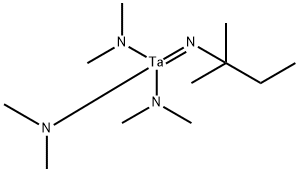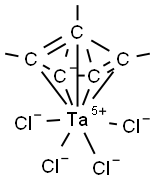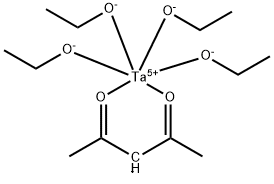TANTALUM TRIS(DIETHYLAMIDO)-TERT-BUTYLIMIDE
Synonym(s):TBTDET;Tris(diethylamino)(tert-butylimino)tantalum(V)
- CAS NO.:169896-41-7
- Empirical Formula: C16H39N4Ta
- Molecular Weight: 468.46
- MDL number: MFCD02684506
- EINECS: 624-910-8
- SAFETY DATA SHEET (SDS)
- Update Date: 2024-12-18 13:37:16

What is TANTALUM TRIS(DIETHYLAMIDO)-TERT-BUTYLIMIDE?
The Uses of TANTALUM TRIS(DIETHYLAMIDO)-TERT-BUTYLIMIDE
Tantalum tris(diethylamido)-tert-butylimide is a useful precursor for the atomic layer deposition of tantalum oxide and tantalum nitride.
The Uses of TANTALUM TRIS(DIETHYLAMIDO)-TERT-BUTYLIMIDE
Tantalum tris(diethylamido)-tert-butylimide is used as a precursor for tantalum nitride.
General Description
Atomic number of base material: 73 Tantalum
Properties of TANTALUM TRIS(DIETHYLAMIDO)-TERT-BUTYLIMIDE
| Boiling point: | 90°C/0.1mm |
| Density | 1.252 g/mL at 25 °C (lit.) |
| Flash point: | 115 °F |
| form | liquid |
| color | colorless to pale yellow |
| Specific Gravity | 1.252 |
| Water Solubility | Reacts with water. |
| Sensitive | Air Sensitive |
| Hydrolytic Sensitivity | 8: reacts rapidly with moisture, water, protic solvents |
| CAS DataBase Reference | 169896-41-7 |
| EPA Substance Registry System | Tantalum, tris(N-ethylethanaminato)[2-methyl-2-propanaminato(2-)]-, (T-4)- (169896-41-7) |
Safety information for TANTALUM TRIS(DIETHYLAMIDO)-TERT-BUTYLIMIDE
| Signal word | Danger |
| Pictogram(s) |
 Flame Flammables GHS02  Corrosion Corrosives GHS05 |
| GHS Hazard Statements |
H226:Flammable liquids H261:Substances And Mixtures Which, In Contact With Water,Emit Flammable Gases H314:Skin corrosion/irritation H318:Serious eye damage/eye irritation |
| Precautionary Statement Codes |
P223:Keep away from any possible contact with water, because of violent reaction and possible flash fire. P280:Wear protective gloves/protective clothing/eye protection/face protection. P231+P232:Handle under inert gas. Protect from moisture. P310:Immediately call a POISON CENTER or doctor/physician. P303+P361+P353:IF ON SKIN (or hair): Remove/Take off Immediately all contaminated clothing. Rinse SKIN with water/shower. P305+P351+P338:IF IN EYES: Rinse cautiously with water for several minutes. Remove contact lenses, if present and easy to do. Continuerinsing. P405:Store locked up. P422:Store contents under … |
Computed Descriptors for TANTALUM TRIS(DIETHYLAMIDO)-TERT-BUTYLIMIDE
New Products
(S)-3-Aminobutanenitrile hydrochloride 4-Methylphenylacetic acid N-Boc-D-alaninol N-BOC-D/L-ALANINOL Tert-butyl bis(2-chloroethyl)carbamate 3-Morpholino-1-(4-nitrophenyl)-5,6-dihydropyridin- 2(1H)-one Furan-2,5-Dicarboxylic Acid Tropic acid 1-Bromo-3,5-Di-Tert-Butylbenzene S-2-CHLORO PROPIONIC ACID ETHYL ISOCYANOACETATE 2-Bromo-1,3-Bis(Dimethylamino)Trimethinium Hexafluorophosphate 4-IODO BENZOIC ACID 3-NITRO-2-METHYL ANILINE 1-(2,4-DICHLOROPHENYL) ETHANAMINE (2-Hydroxyphenyl)acetonitrile 4-Bromopyrazole 2-(Cyanocyclohexyl)acetic acid 4-methoxy-3,5-dinitropyridine 1-(4-(aminomethyl)benzyl)urea hydrochloride 2-aminopropyl benzoate hydrochloride diethyl 2-(2-((tertbutoxycarbonyl)amino) ethyl)malonate tert-butyl 4- (ureidomethyl)benzylcarbamate Ethyl-2-chloro((4-methoxyphenyl)hydrazono)acetateRelated products of tetrahydrofuran








You may like
-
 Tantalum tris (diethylamido)-tert-butylimide CAS 169896-41-7View Details
Tantalum tris (diethylamido)-tert-butylimide CAS 169896-41-7View Details
169896-41-7 -
 Tantalum tris (diethylamido)-tert-butylimide CAS 169896-41-7View Details
Tantalum tris (diethylamido)-tert-butylimide CAS 169896-41-7View Details
169896-41-7 -
 Tris(diethylamido)(tert-butylimido)tantalum(V) CAS 169896-41-7View Details
Tris(diethylamido)(tert-butylimido)tantalum(V) CAS 169896-41-7View Details
169896-41-7 -
 Tris(diethylamido)(tert-butylimido)tantalum(V) CAS 169896-41-7View Details
Tris(diethylamido)(tert-butylimido)tantalum(V) CAS 169896-41-7View Details
169896-41-7 -
 1975-50-4 98%View Details
1975-50-4 98%View Details
1975-50-4 -
 2-HYDROXY BENZYL ALCOHOL 98%View Details
2-HYDROXY BENZYL ALCOHOL 98%View Details
90-01-7 -
 14714-50-2 (2-Hydroxyphenyl)acetonitrile 98+View Details
14714-50-2 (2-Hydroxyphenyl)acetonitrile 98+View Details
14714-50-2 -
 118753-70-1 98+View Details
118753-70-1 98+View Details
118753-70-1
Statement: All products displayed on this website are only used for non medical purposes such as industrial applications or scientific research, and cannot be used for clinical diagnosis or treatment of humans or animals. They are not medicinal or edible.